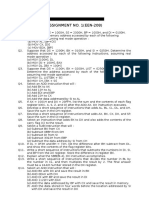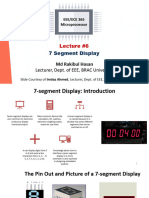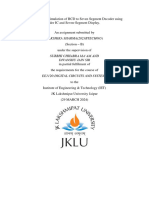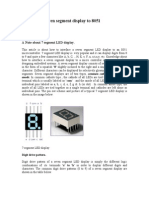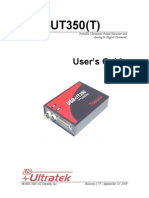PC-based 7 Segment Rolling Display
Uploaded by
Pradnya BhoodharPC-based 7 Segment Rolling Display
Uploaded by
Pradnya BhoodharPC-Based 7-Segment
Rolling Display
It
is very interesting and con
venient to be able to control
everything while sitting at
your PC terminal. Here, a simple
hardware circuit and software is
used to interface a 7-segment based
rolling display.
The printer port of a PC pro-
vides a set of points with some act-
ing as input lines and some others
as output lines. Some lines are open
collector type which can be used as
input lines. The circuit given here
can be used for interfacing with any
type of PC’s printer port.
The 25-pin parallel port connec-
tor at the back of a PC is a combi-
nation of three ports. The address
varies from 378H-37AH. The 7 lines
of port 378H (pins 2 through 8) are
used in this circuit to output the
code for segment display through
IC1. The remaining one line of port
378H (pin 9) and four lines of port
37AH (pins 1, 14, 16, 17) are used
to enable the display digits (one a
time) through IC2.
The bits D0, D1 and D3 of port
37AH connected to pins 1, 14 and 17
of ‘D’ connector are inverted by the
computer before application to the pins PC places the 7-segment code for the first over and over again. Because of this rep-
while data bit D2 is not inverted. There- digit/character on the data bus and ena- etition at a fairly high rate, there is an
fore to get a logic high at any of former bles only the first 7-segment display. After illusion that all the digits/characters are
three pins, we must send logic 0 output to delay of a few milliseconds, the 7-segment continuously being displayed. DISP1 is to
the corresponding pin of port 37AH. code for the digit/character is replaced by be physically placed as the least signifi-
Another important concept illustrated that of the next charter/digit, but this time cant digit.
by the project is the time division multi- only second display digit is enabled. IC1 (74LS244) is an octal buffer which
plexing. Note that all the five 7-segment After the display of all characters/ is primarily used to increase the driving
displays share a common data bus. The digits in this way, the cycle repeats itself capability. It has two groups of four buff-
P r o g r a m
/*DISP.C*** PC BASED ROLLING clrscr(); delay(300);
DISPLAY */ for(f=200;f<=500;f+=100)
/* P.R.DESHMUKH*/ { }
#include<stdio.h> sound(f );
#include<conio.h> delay(100); else
#include<dos.h> } {
#define PORTA 0x378 nosound(); outportb(PORTB,0x0b);
#define PORTB 0x37a while (!kbhit()) outportb(PORTA,m[j]);
void main() { outportb(PORTA ,(m[j] || ( 0x80)));
{ for (j=0;j<=4;j++) delay(300);
int dno[6]={0x0a,0x09,0x0f,0x03,0x80}; { }
/* code for “hallo”*/ outportb(PORTA,m[j]); }
int m[5]={0x76,0x77,0x38,0x38,0x3f }; if(j<=3) }
/*code for the selection of display*/ { }
int f,j; outportb(PORTB,dno[j]);
ELECTRONICS PROJECTS Vol. 20
ers with non-inverted tri-state outputs. Whatever the message/characters to has the appropriate bits turned on. For
The buffer is controlled by two active be displayed (here five characters have example, to display character ‘L’, the
low enable lines. IC2 (75492) can drive been displayed), these are separated segments to be turned on are f, e and
a maximum of six 7-segment displays. and stored in an array. Then these are d. This is equivalent to 111000 binary
(For driving up to seven common-cathode decoded. or 38 hex.
displays one may use ULN2003 described Decoding software is very simple. Please note that only limited char-
in the previous circuit idea.) Just replace the desired character with acters can be formed using 7-segment
The program for rolling display the binary equivalent of the display display. Characters such as M, N and K
is given in the listing DISP.C above. code. The display code is a byte that cannot be formed properly.
ELECTRONICS PROJECTS Vol. 20
You might also like
- Engineering Economic Analysis - Review: University of TorontoNo ratings yetEngineering Economic Analysis - Review: University of Toronto25 pages
- Microcontroller Systems (KON 309E) : Lecture Notes (WEEK 1)No ratings yetMicrocontroller Systems (KON 309E) : Lecture Notes (WEEK 1)8 pages
- Tribhuvan University Institute of Engineering Pulchowk, Lalipur A Lab Report On Embedded SystemNo ratings yetTribhuvan University Institute of Engineering Pulchowk, Lalipur A Lab Report On Embedded System22 pages
- Serial Communication With PIC16F690 by Houston PillayNo ratings yetSerial Communication With PIC16F690 by Houston Pillay12 pages
- Kenwood RXD 652 702 752 772 852 A81 A607 A701No ratings yetKenwood RXD 652 702 752 772 852 A81 A607 A70154 pages
- Microprocessors and Microcontrollers - Lecture Notes, Study Materials and Important Questions AnswersNo ratings yetMicroprocessors and Microcontrollers - Lecture Notes, Study Materials and Important Questions Answers5 pages
- Interfacing The Keyboard To 8051 Micro Controller 11100% (1)Interfacing The Keyboard To 8051 Micro Controller 1110 pages
- Unit 2 Architecture of 8051 MicrocontrollerNo ratings yetUnit 2 Architecture of 8051 Microcontroller25 pages
- Experiment 09 Interfacing Keypad and LCD With PIC18F452 Objective100% (1)Experiment 09 Interfacing Keypad and LCD With PIC18F452 Objective11 pages
- The 8051 Microcontroller and Embedded Systems100% (1)The 8051 Microcontroller and Embedded Systems20 pages
- Osmeoisis 2022-09-06 15-33-19PIC - Mid - C - 7No ratings yetOsmeoisis 2022-09-06 15-33-19PIC - Mid - C - 716 pages
- Interfacing Seven Segment Display To 8051No ratings yetInterfacing Seven Segment Display To 80517 pages
- Fpga Seven-Segment-Display by Using Altera De2-115 Board With Practice and ImplementationNo ratings yetFpga Seven-Segment-Display by Using Altera De2-115 Board With Practice and Implementation7 pages
- Modifications: Before Modification After Modification Set - Tris - B (0x7F) Pin - b7No ratings yetModifications: Before Modification After Modification Set - Tris - B (0x7F) Pin - b77 pages
- Workshop 4: Digital Electronics & MicrocontrollerNo ratings yetWorkshop 4: Digital Electronics & Microcontroller2 pages
- Interfacing Seven Segment Display To 8051No ratings yetInterfacing Seven Segment Display To 80518 pages
- Driving Eight Digit Seven Segment LED DisplayNo ratings yetDriving Eight Digit Seven Segment LED Display5 pages
- LAB 3: I/O I - 7-S D: Nterfacing EG IsplaysNo ratings yetLAB 3: I/O I - 7-S D: Nterfacing EG Isplays4 pages
- 1-Microcontroller Based System Design - CompleteNo ratings yet1-Microcontroller Based System Design - Complete55 pages
- Lab No. 5 Seven Segment Display Interfacing: ObjectivesNo ratings yetLab No. 5 Seven Segment Display Interfacing: Objectives4 pages
- FPGA Seven-Segment-Display by Using Altera DE2-115 Board With Practice and ImplementationNo ratings yetFPGA Seven-Segment-Display by Using Altera DE2-115 Board With Practice and Implementation4 pages
- seven segment display display 0 to 9 program with arduinoNo ratings yetseven segment display display 0 to 9 program with arduino7 pages
- 7-Segment Display Interfacing and Programming - Embedded Club 4 UNo ratings yet7-Segment Display Interfacing and Programming - Embedded Club 4 U8 pages
- Objective:: Lab#10: 7-Segment Display SSUET/QR/114No ratings yetObjective:: Lab#10: 7-Segment Display SSUET/QR/1144 pages
- Interfacing 7(Seven) Segment Display to 8051 MicrocontrollerNo ratings yetInterfacing 7(Seven) Segment Display to 8051 Microcontroller21 pages
- Sistema de Suministro de Energìa Electrica de AeronavesNo ratings yetSistema de Suministro de Energìa Electrica de Aeronaves4 pages
- Design and Verification of AMBA APB ProtocolNo ratings yetDesign and Verification of AMBA APB Protocol8 pages
- (EDB) Reiri For Office (Touchscreen) DHOS-CS-DS-21-002CNo ratings yet(EDB) Reiri For Office (Touchscreen) DHOS-CS-DS-21-002C4 pages
- Rigid Truck/Tractor: Average Visibility Average Visibility Average VisibilityNo ratings yetRigid Truck/Tractor: Average Visibility Average Visibility Average Visibility5 pages
- Schneider Electric - Altistart-22 - ATS22C11QNo ratings yetSchneider Electric - Altistart-22 - ATS22C11Q16 pages

















